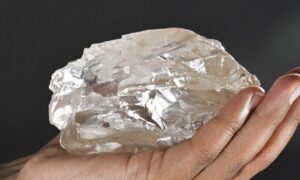It’s hard to overstate the rarity of the Hope and Koh-i-noor diamonds. The stones, excavated from shallow placer mines in India between 1600-1800, are equally famous for their size and clarity. The Koh-i-noor, which is set in the Queen Mother’s Crown of England but India has demanded back, weighs a titanic 105.6 carats.
Together, they are called the Golconda stones. Legends swirl around them like the colonialism and controversy that plagued their discovery.
The Hope diamond changed royal hands via the hyperviolence of the French Revolution.
View this post on Instagram
According to legend, the slave who found one of the collection’s most astonishing examples, the 140-carat Regent diamond, stashed it inside a self-inflicted leg wound and smuggled it to India’s coast in exchange for a cut of the sale and safe passage out of the country.
The stones now belong to some of the world’s most exclusive collections: the British Crown Jewels (Koh-i-noor), and the Smithsonian National Museum of Natural History (Hope Diamond). By 1830, the mine itself had been picked clean.
Mysterious origins
But where did the diamonds originate? Human hands first touched them in a shallow silt deposit along a riverbed, but we’ve never found the natural cauldron that originally forged the singular stones.
Now, though, anyone hunting the location has their first lead. Research published March 15 in the Journal of Earth System Science suggests the Golconda diamonds originated in the Wajrakarur kimberlite field in modern-day Andhra Pradesh — about 300 kilometers from the placer mine site.
It’s still not a sure thing, geochemists warn. And oddly enough, the main obstacle is the diamonds’ purity.
According to Smithsonian magazine, all known diamonds have formed in a zone about 160km underground in the Earth’s mantle. There, intense heat and pressure create crystals inside shifting solid rock. It takes the crystals an astonishing 1 to 3.3 billion years to mature into diamonds.
They eventually rocket to the surface through Kimberlite pipes — a specific type of volcanic rock structure. It takes a highly violent eruption to disgorge a diamond. Most such events likely took place during the Cretaceous, and the planet has likely seen very few, if any, since.
Flaws give clues
Along this turbulent journey, diamonds collect impurities — traces of materials and fluids that ingress during the stone’s formation. These inclusions are extremely minimal in gem-quality stones, but they also provide almost the only clue to their origins, because they indicate geological conditions during their growth.
A team from India’s Savitribai Phule Pune University led the recent effort to trace the Golconda diamonds. The group used a multi-pronged approach involving “bulk rock” geochemistry, field and remote GIS (Geographic Information Systems) study, and paleogeology. Focusing on the chemical compositions of kimberlites surrounding the Krishna River mine site, their findings indicated the Wajrakarur kimberlite field as a possible source.
One shortcoming of their study is that it involved only the upper mantle, one geochemist pointed out to LiveScience. According to the Hebrew University of Jerusalem’s Yaakov Weiss, larger diamonds are thought to form even deeper under the surface.
So pure, they’re hard to trace
Finally, because the Golconda diamonds are so pure in composition, it’s exceedingly difficult to connect them to a specific time or place. While the Wajrakarur kimberlite is capable of yielding diamonds, Weiss asserted it would be difficult to demonstrate a chemical linkage.
Other details are more promising. The Savitribai Phule Pune University team did confirm an ancient river channel once connected the Wajrakarur region with the Krishna River placer mine site.
Their work also excluded another local diamond factory from contention: lamproite deposits in the Eastern Dharwar Craton.
We may still be far from knowing when and where the Golconda stones were born. Then again, who could have guessed we would find them hiding under just seven meters of river silt?






